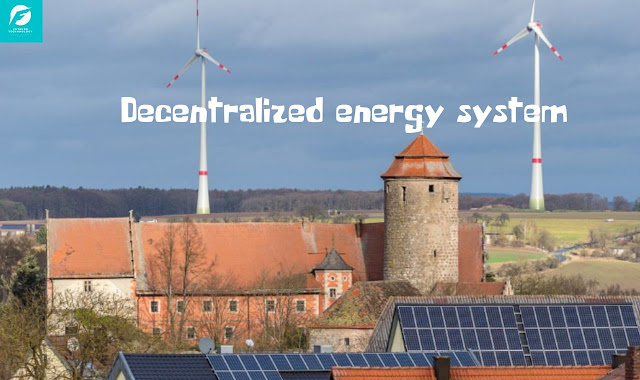 |
| The decentralized energy system |
The energy transmission system that currently prevails in Europe and, more
broadly, in the rest of the world, is the centralized energy management system.
It is an energy system in which energy is first produced in large power
stations located far from consumers, then transmitted through high-voltage
transmission lines and distributed to end users using power grids as an
intermediary. As ideal as the centralized system may seem, it does not exist
without its flaws, which can be subsumed under the environmental, economic,
technical, and social impacts it leaves on network operators and energy
suppliers, and consumers. . Furthermore, the growing global adoption of several
neo-infrastructural systems designed to replace existing power generation
facilities has proven that if smart grids - which are essential to meet
incorruptibly the growing demand energy - must be maintained, it is imperative
to multiply a more efficient and sustainable system, which has already been
established - the decentralization of the transport system and energy
management.
What is a
decentralized energy management system and why is it important?
A decentralized
energy management system corresponds to the situation of
relatively smaller electricity production facilities closer to consumers.
Decentralization essentially aims to bridge the physical gap between
electricity producers and their consumers through micro-grids to enable more
optimal use of renewable energy.
 |
| The decentralized energy system |
Below we explain why we believe that the decentralized energy management system
is necessary to achieve our climate goals and sustainable electricity grid
systems.
1. Reduction of
technical losses in distribution lines.
One of the main causes of transmission losses is the length of distribution
lines. When electricity is generated, collisions occur between electrons moving
from one end to the other. These collisions result in electrical resistance
and, in effect, heat. Without proper harvesting and storage, the heat generated
by this electrical resistance is lost. The magnitude of electrical losses in
the form of heat is proportional to the transmission distance. In principle, by
definition, centralized systems contribute to this failure due to the
remoteness of power generation. Decentralized energy management systems remedy
this thanks to the proximity between supply and demand. Network operators and
energy suppliers derive considerable benefit from this, as they can adequately
circumvent the expenses associated with these losses which would otherwise have
multiplied the unnecessary costs associated with the centralized system.
2. Planning
flexibility
With decentralized
energy management systems, grid operators and energy
suppliers can make efficient decisions without being hampered by the
intricacies of the centralized system, which is designed to rigidify its modes
of transmission and lack thereof. When we talk about the centralized system, we
mean a system where energy demands mutually depend on a single source of supply
at a fault. Suppose an entire state, for example, is supplied with electricity
by a power plant. In this case, all consumers residing in that state are
subject to the same probable implications, such as a blackout or transformer
cut-out. This is another fault that decentralized energy management systems
hope to correct. This is another flaw that decentralized energy management
systems hope to correct. With these systems, consumer communities do not need
to depend on a specific grid for supply, as there are a variety of options for
drawing power if a grid fails. This benefit is two-fold: it fosters a sense of
community among power sector players, where reliability is enhanced, and a
particular power plant does not suffer as much damage if its supply system
fails, compared to an independent system devoid of interconnected networks with
sim power stations islands or others.
3. Rural and remote
electrification
With large power plants located far from end users, transmission to remote
rural areas becomes a challenge posed by distance, scales of preferences, local
acceptance and participation, and funding. Rural communities, by general
definition, have nothing to envy their urban counterparts in areas such as
technological advancement, economic contributions, and population. These,
together with the challenges we highlighted in the previous paragraph,
compromise their access to the power supply and cause their energy needs to be
taken for granted.
Renewable energies in the EU
With the decentralization of energy management, it becomes easier for
independent smart grid operators and energy providers to install local power
plants near these rural communities that have little or no access to
electricity. The presence of these smart grids in small communities contributes
to the efficient and cost-effective distribution of electricity due to their
proximity.
4. A closer
technical relationship between energy retailers and consumers
Decentralized energy management systems are driving the adoption of smart grids
and the integration of the Internet of Things into electrical systems. The use
of advanced metering systems facilitates communication between grid operators
and prosumers, who can now, thanks to the integration of smart meters and the
Internet of Things, resell the excess energy supplied to the grid if they are
connected to the network or store it for later use if they are off-grid. In
addition, it allows energy suppliers to closely monitor electrical situations
at prosumers, easily obtain data and work with the received data. This
relationship between energy suppliers and consumers within shorter radiuses
allows network operators and energy suppliers to save costs that would have
been incurred by excess energy losses, energy theft, and transmission failures.
5. Lower investment
costs per project
The establishment of centralized, larger power plants requires large financial
budgets. This includes the high cost of network extension and a
disproportionate price-to-consumer ratio. With centralized energy management
systems, energy providers often struggle to effectively control energy usage in
remote areas, hence the corresponding challenge associated with billing.
As a result, rural communities with low population density and, on average,
poorer economies, typically receive more electricity than needed and cannot
keep up with the electricity costs that their urban neighbors can afford. These
shortcomings lead to a progressive rejection of the electricity supply or a
categorical refusal to pay more than necessary, which leads to additional costs
for the suppliers. When energy management becomes decentralized, the
corresponding electricity supply becomes more tailored to the precise needs of
consumers. Therefore, network operators and energy providers need not worry
about incurring financial losses due to extravagant provision of electricity
for purposes with minimal demand. Finally, small decentralized power plants
cost less to set up, control and operate than large centralized power plants.
6. Quality services
resulting from a healthy energy ecosystem
Centralized energy management systems come with a monopoly of energy supply
services. Consumers are stuck with a single source of supply and must come to
terms with the quality of service they receive. To minimize or completely
prevent this kind of situation, energy management systems must be
decentralized. Thus, energy suppliers and smart grid operators can install
their infrastructure close to their end users, allowing them to choose from a
wide range of options. In addition, the increase in supply forces players in
the energy sector to improve the quality of their services. This competitive
ecosystem is a driving force that helps promote the sustainability of smart
grids, as each energy supplier will be motivated, today more than ever, to seek
and employ the best measures necessary for improvement.
7. Efficient use of
combined heat and power systems
Combined heat and power (CHP) systems produce electricity while storing the by-product
of that power generation, namely usable heat, for use in a single process.
centralized energy management systems, the heat produced as a by-product of
electricity generation causes damage or is relegated to waste. With
decentralized energy management systems, on the other hand, this heat can be
captured, stored, and made useful for heating and even cooling households and
industries. With proper use of this waste heat, cogeneration plants can become
80% more efficient than gas-fired plants in the UK, which are environmentally
unfriendly and have between 49% and 52% efficiency. decentralized energy
management systems are local. Here, local does not necessarily mean rural, but
rather, not large scale. Every smart grid can exploit this advantage by trapping
waste heat to make local heat in combination with electrical power while
avoiding energy losses that would have occurred during transmission between
power generation sources. centralized and their users.
 |
| The decentralized energy system |
Conclusion
Centralized energy management systems are the usual and predominant way of
transmitting and managing energy in Europe. They have both advantages and
disadvantages. The gradual shift to renewable energy sources informs us of the
need to make energy sources sustainable if we are to meet peaks in global
demand without jeopardizing our climate goals and simultaneously putting our
supply systems in danger of collapse or discredit. Decentralized energy
management systems have technical and economic advantages for local energy
players and consumers. Supply, demand, and transmission can be easily monitored
and executed without additional complexities. As a result, the transmission
monopoly is erased, and a healthier relationship between producer and consumer
is maintained.















No comments:
Post a Comment